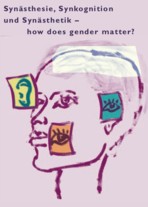Synesthesia

The College’s Cognitive Interest in Synesthesia
The research on synesthesia is interesting for different scientific disciplines. In recent findings, gender aspects are taken into account, which leads to surprising results. During the past decades, it was claimed that more women than men were synesthetes. Synesthisia was thought to be passed on by the x-chromosome, a genetic determination seemed probable. The case of genetically identic twins, only one of which was a synesthete, proved these speculations to be false (Smilek et al. 2005). Genes are probably involved in the process of developing synesthesia, but are not the only factor. The observation of most synesthetes being women seems to be a result of the research methods chosen. Systematic research on the prevalence of synesthesia are rare. Most studies are based on the self-perception of synesthetes (e.g. Baron-Cohen et al. 1996). Therefore one might argue that if and how synesthetes mention their disposition and talk about their experiences is link to their concept of gender.
